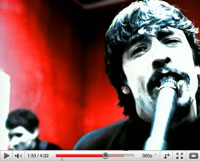This week I’m going to be talking about the difference between driving the bus and riding the bus – but don’t worry, we aren’t taking a detour into public transport.
By focusing your ears on the tricks used by great musicians to seamlessly shift attention between different instruments we will unravel some of the mysteries of arranging and find common ground between such diverse genres as jazz, soul and hard rock.
Hail To The Bus Driver
Way back when I was still at university I attended a jazz gig put on by some students of the Birmingham Conservatoire. Now there was no doubt the band was cooking; the pianist in particular had a ferocious style, dropping Bach-influenced baroque flourishes into jazz standards. Despite the virtuosity on display something was amiss that as a jazz novice I couldn’t quite put my finger on. When they played their interpretation of the wonderful Miles Davis track “So What” it seemed crowded and claustrophobic, where the original was airy and free.
“They didn’t know who was driving the bus” interjected a stranger as we discussed it in the bar afterwards. I was confused; but he looked every bit the finger clicking, Jean Paul Sartre reading hep cat so I asked him to explain.
“They know how to solo, but they don’t know how to comp. You’ve always gotta know who’s driving the bus, and who’s riding the bus.”
I must confess this didn’t make a great deal of sense to me either, but I made mental note to unravel the mysteries of “comping” and “riding the bus”…
The Complex art of Comping
What is the Dorian Mode?
If you aren’t familiar with “modes” you can think of the Dorian Mode as the white notes of a piano played from D to D, or a Natural Minor with a Major 6th. And if that doesn’t help listen to pretty much any Carlos Santana solo (but rather you than me).
“Comping” it turns out is short for accompanying, but it might just as well be short for complementing. When a jazz musician solos, a chordal instrument (usually a piano or guitar) will play chords under the melody, setting a harmonic context for the improvisation. The true skill of comping is to learn how to listen while you play, matching the chords to the melody.
Take a track like “So What”: it has no tightly defined chord sequence and is based around the Eb and D Dorian modes. When the structured introductory section gives way to Miles’ lyrical solo at 1:30 Bill Evans masterfully improvises clipped piano chords, setting the mood without stepping on the trumpet’s toes. Piano players aren’t the only ones who comp; listen to the way drummer Jimmy Cobb accents beats to emphasize the boisterous and carefree saxophone melody from 5:45 onwards.
Magic Bus?
Booker T & The MGs
When skilled musicians play together a lot they develop something almost akin to a psychic link. One of the greatest examples in the history of popular music is Booker T and the MGs, the house band of Stax Records. They played on dozens of hit records for the likes of Sam & Dave (the line “Play it Steve” in Soul Man refers to Cropper) and Otis Reading, but are best known for the instrumental tracks “Green Onions” and “Soul Limbo” – or “the BBC cricket music” as it is known in Britain!
The origin of the phrase “Driving the bus” took me a little longer, but a spell playing guitar in a funk/soul band was just the education I needed. In an 8-piece band with keys and horns it’s very easy for the music to become a mess, and musical clutter seldom gets bums off seats or backs off the wall. In a funk band it is essential that every musician understands who is “driving the bus”: that is, the musician who is acting as a focal point for the audience. It’s often the vocalist or a player taking a solo, but it equally could be a great guitar riff or keyboard hook. A professional musician knows that when they are riding the bus their job is to ditch the ego and use their ears to make the bus driver sound good. You should expect nothing less in return when the roles are reversed!
Soul musicians comp in much the same way as jazz musicians, albeit usually around simpler repeating chord structures. Listen to the first 30 seconds of Booker T & the MGs’ classic 12 bar blues instrumental “Green Onions” and you will hear guitarist Steve Cropper playing tight staccato chords (not unlike Bill Evans part in “So What”) leaving plenty of room for the organ of Booker T Jones to take centre stage. He then drops back further to double the bass line an octave up during the organ solo, then moves into the foreground for the solo (1:10).
Songwriting Nirvana
So far the music we have considered has been instrumental. With vocal music the singer is (almost by default) driving the bus whenever they are singing. The easiest way for a drummer to blow an audition is to drop a busy fill over a lyric, but what if the singer wants to ride the bus while a killer riff takes the wheel?
One way is using a linear melody: one where the notes have little variation in pitch. These are typically used by artists who want to focus attention on the lyrics (think Bob Dylan or Bruce Springsteen), but they can also allow a cool instrumental hook to take center stage.
For all the back-to-basics ethos of Grunge, Kurt Cobain was a master songwriter. Say “sing me ‘Smells Like Teen Spirit’” to any rock fan and they will most likely adopt an air guitar pose and intone “Ner-Ner-Ner,chika-chika, Ner-Ner” in preference to the vocal melody.
So how did Kurt avoid crashing the riff? Listen to the chorus (1:05) and you will hear that the melody is almost entirely linear, with each phrase consisting of two notes which line up with a chord change. The meter of the lyric (an unwavering chant of two eighth notes followed by two quarter notes) also prevents the listener from being distracted. Virtuoso drummer Dave Grohl also comps perfectly, placing bass drum notes on the accents of the chord riff and snare beats to enhance the distinctive “chika-chicka” guitar mutes between chords.
Contrast this with the verse: the melody moves up and down freely and the metre and lyrics are denser. Recognising this as the focus, the drums stick to the most basic of rock beats and the guitar is restricted to a ringing C and F note (compare this to the sparse comping of Cropper or Evans).
Funky Gibbon
Busman’s Holiday?
When writing these kinds of articles it is customary to give a counterexample, but so central is the concept of driving the bus to popular music it is difficult to find a successful band who regularly contravene it. Amongst those starting out in music, singers at acoustic nights often make the fatal mistake of playing 16 bars of strummed chords when playing a song with an instrumental break or introduction – having no one driving is sometimes worse than two people! This is where developing a combined “rhythm and lead” finger picking style, or the courage to mess with the song structure pays dividends. Young rock bands often have the converse problem of “Lead-guitar-itis” where, desperate to show off their hard won chops, musicians will throw extravagant full volume runs over the most delicate of vocal melodies.
If you are going to break this most golden of rules you had better make sure that you have the skills to back it up. And so to bring everything full circle, let’s turn our attention back to one of my favorite modern jazz combos: The Bad Plus.
On their beautiful re-imagining of the Pink Floyd classic “Comfortably Numb” the band are wonderfully restrained, allowing guest vocalist Wendy Lewis to shine. In the final chorus however (5:00) the band diverge into rhythmic and harmonic ideas that clash with the vocal, evoking the madness and paranoia that is the song’s subject matter, before returning to a powerful unity at the song’s climax (5:40).
Down at the Bus Station at Midnight
The concept of driving the bus is a simple one, but it’s one that has proved invaluable to me when writing, arranging, or appreciating music. Some elements of ear training can appear intimidating to those of us that didn’t approach music from a classical education – But listening for the focal point in an arrangement is a simple exercise that can be a gateway to a deeper understanding of why the composer or arranger made the choices they did.
The “Six Thinking Hats” approach is a popular technique in problem solving, and as musicians our thinking hats include Melodic, Harmonic, Timbrel, Dynamic and Rhythmic. Adding a Bus Driver‘s hat to the mix and thinking about the focus of the listener may add a new perspective to your analysis.
So next time you are listening to your friend’s demo tape and something sounds a bit off, or you find yourself wondering why everyone goes to the bar when you play your new song:








